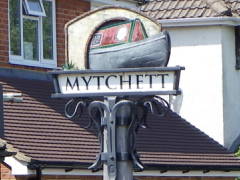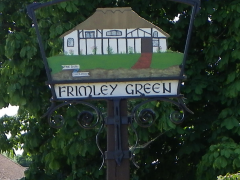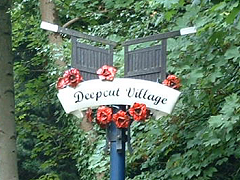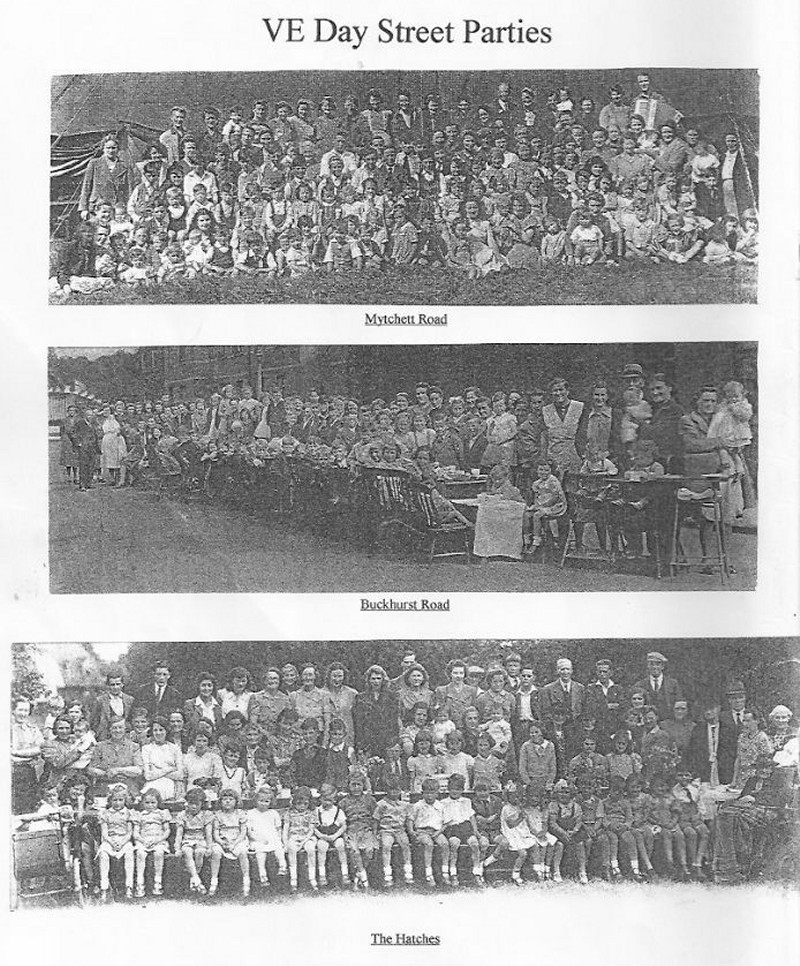|
Author - Graham O'Connell
 The roots of the Society can be traced back to 1960 with the formation of the Mytchett & Frimley Green Residents Association.
Founding members included Dennis James, our first chairman, Gerald Coveney and Sid Moore, who went on to gain an MBE in 2000
for his work in the community.
The roots of the Society can be traced back to 1960 with the formation of the Mytchett & Frimley Green Residents Association.
Founding members included Dennis James, our first chairman, Gerald Coveney and Sid Moore, who went on to gain an MBE in 2000
for his work in the community.
The early work of the Association was not that different to today with a strong focus on the everyday things that concern residents -
planning applications, traffic and roads. A typical letter to the then council, the Frimley & Camberley Urban District Council,
in 1963 took them to task on the state of the roads, paths and caravan sites.
Occasionally big issues come along and the Association voiced their views on behalf of residents. In 1977 that included the
Airport Strategy of Great Britain, and we have kept a close eye on developments at Farnborough Airport ever since as although
it is out of our area the aircraft movements have a big impact on those near the flight path.
 Also in 1977 the Association objected to a planning application for housing at Frimley Lodge Farm, now Frimley Lodge Park.
Clearly one of our successes. Ten years later in 1987 we expressed concerns about the late addition of a junction on the
Blackwater Valley Road at Coleford Bridge Road. A little less successful on that one.
Also in 1977 the Association objected to a planning application for housing at Frimley Lodge Farm, now Frimley Lodge Park.
Clearly one of our successes. Ten years later in 1987 we expressed concerns about the late addition of a junction on the
Blackwater Valley Road at Coleford Bridge Road. A little less successful on that one.
Also in 1987 we set out detailed concerns about the new pedestrian crossings as part of the experimental changes to the junction in Frimley Green.
Some changes were made to those crossings but the ‘experiment’ - adding mini-roundabouts - proved to be successful and we have been part of the fight
to retain them from 2015 to 2020.
In 2000 the Mytchett, Frimley Green & Deepcut Residents Association changed their name to the current one: the Mytchett, Frimley Green & Deepcut Society.
Still campaigning on behalf of residents in the three villages and playing an important role in major developments including the new housing scheme in Deepcut.
 Following the lead in Frimley Green where a new village sign was put up by the Carnival Committee in 2000, the Society sought funding and organised new village signs
for Mytchett and Deepcut in 2001 along with mass planting of daffodils in all three village.
Following the lead in Frimley Green where a new village sign was put up by the Carnival Committee in 2000, the Society sought funding and organised new village signs
for Mytchett and Deepcut in 2001 along with mass planting of daffodils in all three village.
We are a non-political organisation but some of our committee members have extended their involvement in the local community gaining election as
councillors either before or after being committee members, though never at the same time. We won’t list them all here but, as an example, Alan Barnett,
a former committee member, went on to become Mayor in 1990 and later returned becoming chairman of the Society.
A number of committee members have stayed with us for many years - so it can’t be all bad being on the committee! Among them, as at 2020,
are Sue Cartwight, Carol Drew and Howard Hyde.
Today we are helped by technology with a website, social media accounts and Zoom meetings. But the task of supporting and improving our local area goes
on just the same. To see what we are up to at the moment go to our Society News page.
|
|
Author - Graham O'Connell
Our three village are part of what we now call Surrey Heath, so named because of the large areas of heathland. This area has been populated since Prehistoric times and to a
large extent the heathland was created by overgrazing during the Neolithic period.
Frimley Green
Frimley is a Saxon name from Fremma's Leah meaning Fremma's woodland clearing. In the 13th Century it was part of the chapelry of Ash and was later sold to Chertsey Abbey in 1277.
Frimley Green established its own identity in 1889 when the first church was built, until then it was known as South End. Now a suburban village of 580 acres, to anyone passing
through it seems once again to be barely separable from Frimley.
Mytchett
To the south of Frimley Green is Mytchett. Formerly farmland and large unproductive areas of waste land, a village started to form in the early 1900s at the crossroads adjoining Michet Farm.
Starting in the 1930s housing has steadily grown to produce the village we know today.
Deepcut
To the east of Frimley Green is Deepcut which gained its name after the deep cutting made for the Basingstoke canal in the 18th Century. In 1903 a house and land was sold to the army to become
the home of the Royal Engineers. Blackdown Camp, as it was called, later became Deepcut Barracks. The village is set to be transformed by major new housing developments.
Early Life in the Area
Various farms existed, such as Cross Farm which dates from the 15th Century, and some still remain as private homes. Sheep, many of them descendants of Welsh or Celtic flocks, roamed on the heathland.
In Tudor times there were common fields where people would have work communally rather than using the strip rotation method used in more fertile areas.
In 1770 Warren Farm listed produce as wheat, barley, rye, peas beans and oats. From the name you can also deduce that they kept rabbits. Other things grown locally included apples, pears, plums, hops,
mustard seed and flax. Most farms would also have chickens and perhaps a few cows, goats, pigs and bees. The most valued bird kept by smallholders were geese. They were often kept on common land,
which explains why the village green in Frimley Green was formerly known as Goose Garsen Green.
The roots of heather and gorse were used as fuel for heating and to cook food. Bracken was used for animal bedding. Heather was used for thatching and sheep dung was used for improving the soil.
In the 19th Century sheep farming declined whilst plant nurseries and the harvesting of timber began to grow.
The earliest known pottery in the area was at Potshop Field (by what is now Potteries Lane, Mytchett). Another was at Deeks Lane in Frimley Green. Potter’s Pool, by the canal, was formed as a result
of clay being extracted. The pots made in this area were fairly plain and intended for general domestic use.
Other trades that emerged over the years including the usual mix you might find in any village such as blacksmiths, millers and shopkeepers, broom-makers, cordwainers -
making and repairing boots and shoes - and wheelwrights.
In the early 1900s people started to look further afield for employment such as in the now growing Camberley and at the balloon factory in Farnborough, both a cycle ride away as there was still no public transport.
Our strong connection with the military continued through the war years and remains to this day.
For more information about the history of our three villages, including people, places and stories, go to:
Links:
Surrey Heath Museum - www.surreyheath.gov.uk/visitors/surrey-heath-museum
Surrey Heath Local History Club - www.surreyheath.gov.uk/visitors/surrey-heath-museum
Francis Frith (local photographs) - www.francisfrith.com/uk/frimley-green
Ken Clarke Books - www.kenclarkebooks.co.uk/publications
Archaeological Report: Mytchett - vas.co.uk/reports/pdf/CFM07-59dsk.pdf
Books:
Frimley Green: A Village History by Heather Toynbee
An English Village at War: Mytchett and Frimley Green 1939 to 1945 by Roy Forster
Princess Royal Barracks, Deepcut by Ronald Cohn Jesse Russell
Old Frimley, including the Old Warren Estate, St Peter’s Church & other stories by Miss Daisy Hills
Life and Work on Surrey Heath by Mary Bennett
A Guide to the Industrial History of Surrey Heath Borough by John Mills
Medieval Surrey Heath by Phil Stevens
A History of the Basingstoke Canal by Glenys Crocker, Roger Cansdale, Dieter Jebens
VE Day Tuesday 8th May 1945
Like almost everywhere in the country there were plenty of local celebrations. A large bonfire was built on the crest of the hill in the Recreation Ground, Frimley Green. The landlord of the Rose and Thistle
brought his radiogram onto the green to play and there were also celebrations on Watchett’s Recreation Ground.
Over the next few days a spate of street parties were organised, in Hamesmoor Road, Chobham Road, The Hatches, Mytchett Road and Buckhurst Road to name but a few.
There must be many stories, some now forgotten, but this one by Eileen Head from Mytchett Barracks comes from the People’s War Archive:
“We had big celebrations on the following Saturday, including a female football match, Drivers versus Office staff. I didn’t know the first thing about football, few of us did, we were told which was our goal then
the whistle blew and we were off. I think we lost track of which goal was ours, we were too busy chasing the ball. All I can remember about it really, was seeing all the men watching, rolling on the ground helpless
with laughter. Our side won, I don’t quite know how but we got a big cheer, so did the losers. I don’t think the men had had such a good laugh for long enough.”
Below are 3 photos of VE Day Street parties (Mytchett Road, Buckhurst and The Hatches) from the back of Roy Forster's booklet:

Lest we forget, the roll of honour for those who gave their lives can be found here:
www.roll-of-honour.com/Surrey/FrimleyGreen.html
|

